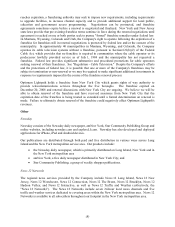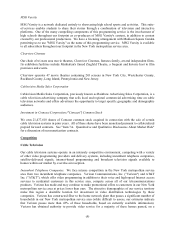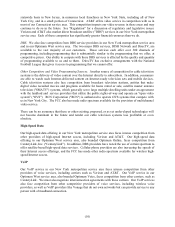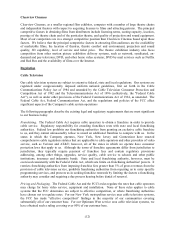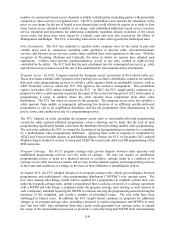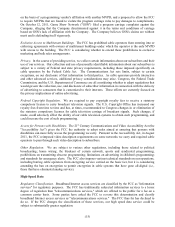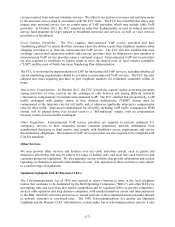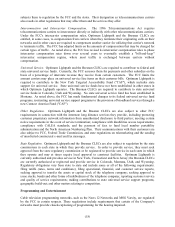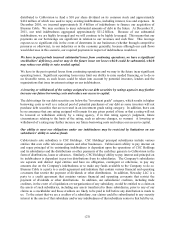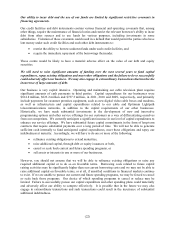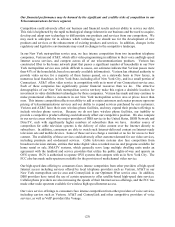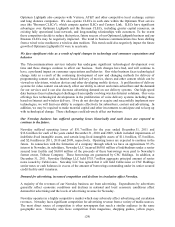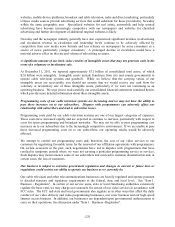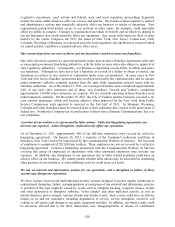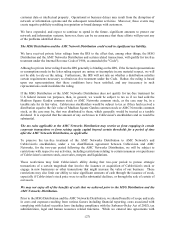Cablevision 2011 Annual Report Download - page 24
Download and view the complete annual report
Please find page 24 of the 2011 Cablevision annual report below. You can navigate through the pages in the report by either clicking on the pages listed below, or by using the keyword search tool below to find specific information within the annual report.(18)
subjects them to regulation by the FCC and the states. Their designation as telecommunications carriers
also results in other regulations that may affect them and the services they offer.
Interconnection and Intercarrier Compensation. The 1996 Telecommunications Act requires
telecommunications carriers to interconnect directly or indirectly with other telecommunications carriers.
Under the FCC's intercarrier compensation rules, Optimum Lightpath and the Bresnan CLECs are
entitled, in some cases, to compensation from carriers when they terminate their originating calls on their
networks and in other cases are required to compensate another carrier for utilizing that carrier's network
to terminate traffic. The FCC has adopted limits on the amounts of compensation that may be charged for
certain types of traffic. As noted above, the FCC has revised its intercarrier compensation rules to phase
intercarrier compensation rates down over several years to eventually establish a "bill-and-keep"
intercarrier compensation regime, where most traffic is exchanged between carriers without
compensation.
Universal Service. Optimum Lightpath and the Bresnan CLECs are required to contribute to federal and
state universal service funds. Currently, the FCC assesses them for payments and other subsidies on the
basis of a percentage of interstate revenue they receive from certain customers. The FCC limits the
amount carriers may place on universal service line items on their customer bills. Optimum Lightpath is
required to contribute to the New York Targeted Accessibility Fund ("TAF"), which includes state
support for universal service. State universal service funds have not been established in other states in
which Optimum Lightpath operates. The Bresnan CLECs are required to contribute to state universal
service funds in Colorado, Utah and Wyoming. No state universal service fund has been established in
Montana. As noted above, the FCC has made fundamental changes to its federal universal service fund
programs, reorienting universal service support programs to the provision of broadband services through a
new Connect America Fund ("CAF").
Other Regulation. Optimum Lightpath and the Bresnan CLECs are also subject to other FCC
requirements in connection with the interstate long distance services they provide, including protecting
customer proprietary network information from unauthorized disclosure to third parties; meeting certain
notice requirements in the event of service termination; compliance with disabilities access requirements;
compliance with CALEA standards; and the payment of fees to fund local number portability
administration and the North American Numbering Plan. Their communications with their customers are
also subject to FCC, Federal Trade Commission, and state regulations on telemarketing and the sending
of unsolicited commercial e-mail and fax messages.
State Regulation. Optimum Lightpath and the Bresnan CLECs are also subject to regulation by the state
commissions in each state in which they provide service. In order to provide service, they must seek
approval from the state regulatory commission or be registered to provide service in each state in which
they operate and may at times require local approval to construct facilities. Optimum Lightpath is
currently authorized and provides service in New York, Connecticut and New Jersey; the Bresnan CLECs
are currently authorized or registered and provide service in Colorado, Montana, Utah, and Wyoming.
Regulatory obligations vary from state to state and include some or all of the following requirements:
filing tariffs (rates, terms and conditions); filing operational, financial, and customer service reports;
seeking approval to transfer the assets or capital stock of the telephone company; seeking approval to
issue stocks, bonds and other forms of indebtedness of the telephone company; reporting customer service
and quality of service requirements; making contributions to state universal service support programs;
geographic build-out; and other matters relating to competition.
Programming and Entertainment
Cable television programming networks, such as the News 12 Networks and MSG Varsity, are regulated
by the FCC in certain respects. These regulations include requirements that certain of the Company's
networks must provide closed-captioning of programming for the hearing impaired.


